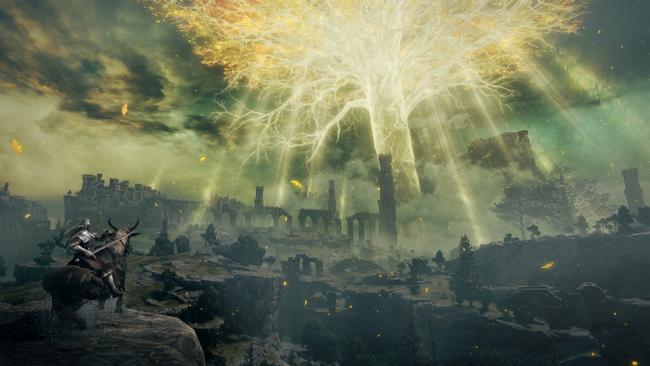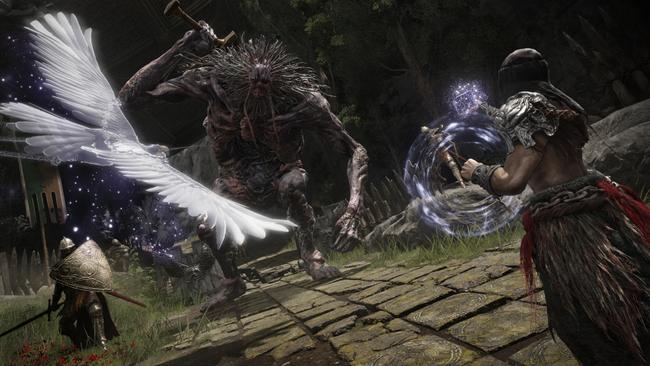
Elden Ring hands-on: a formidable, open adventure - and possibly FromSoftware’s best game yet
Elden Ring is a lot. I think we all had a bit of a feeling this game was going to be pretty good, but after spending many hours with the Closed Network Test version that’ll soon be made available to a select group of the public, it’s fair to say that I still wasn’t quite prepared for what this game wants to offer. These games have always been formidable, but Elden Ring is in a whole new way: in its scope and ambition.
Elden Ring is of course the latest game developed by FromSoftware, and is essentially the newest entry in the ‘Souls’ series- that is Dark & Demon’s Souls, Sekiro, and Bloodborne. Just as Sekiro and Bloodborne spun off from the core of Souls with something new, so too does Elden Ring - though it’s a more direct follow-up to Dark Souls 3 than its peers.
When you start up the beta build, much feels similar to Souls. The sound, look, and general mood of the menus sets the tone. You first pick from a handful of pre-set classes (this is just for the beta; you’ll have traditional character creation in the final build), and you’re dropped into a dark dungeon which also features the ‘Cave of Knowledge’, an optional tutorial zone.
After its first few minutes, Elden Ring opens up and draws the player in with tendrils unstoppable enough that they’d feel at home attached to any of the game’s show-stopping bosses. You open one of the series’ traditionally hefty doors - but what extends before you is unlike anything FromSoftware has attempted before. This is a true, wide open world - and what waits is not just challenge and death, but also plenty of decision-making.

The choice thrust upon the player is how Elden Ring most differentiates itself from past Souls titles. In reductive terms, we can split the game into two sections: the wild open world of ‘The Lands Between’, the game’s overworld, and ‘Legacies’ - dungeons, castles, and other more cramped environments that function much more like traditional Souls zones. You’ll spend the game traversing the overworld to access new Legacies, plundering their depths to gain loot and Runes, the currency that replaces Souls in this new lore. The big difference, of course, is that not all legacies are required reading.
Previous games have had some degree of optional content, but nothing like in Elden Ring, at least based on this early demo. To bee-line to the demo’s main boss, a multi-armed beast man who mocks your protagonist ‘Tarnished’ for their lowly status, will take only a handful minutes from when the game spits you out into the open world. But to do that, you’d have to be greatly skilled to not die at his hand - and you’d miss out on a bunch of other fascinating content.
Some of that action is out in the overworld. You might find a small squad of enemy soldiers camping at and guarding the ruins of an old town center. You can take them on - at range, or close up, or by sneaking around the town ruins backstabbing them one-by-one, with stealth seemingly far more viable this time around. If you do so, you’ll earn valuable runes to level up, but also invariably find some treasure or another hidden in the town. Alternatively, you might stumble across a dungeon entrance or be pointed towards it by a friendly NPC. Within, you’ll find enemies, loot, and even bespoke boss encounters - entirely missable, just waiting for you out in the world.
In some nebulous manner, it feels more truly RPG-like, with the grind contextualized. In Dark Souls, generally speaking, if you’re bouncing off a boss you’ve two options: learn the patterns and improve (aka ‘git gud’), or backtrack and cheese the Bonfire system to grind out a bunch of souls to buy some character progression upgrades. In Elden Ring, it makes more sense: if you bounce off a boss, you can simply head out into the open world and find other stuff to do. Through that, you’ll naturally grow and improve, and then you can come back to it later. In that sense, this might be the most accessible Souls to date, with options for those who lose patience if they get stuck for more than half an hour. Don’t mistake this sliver of accessibility for being easy, by the way: Elden Ring is still tough, with bosses that’ll curbstomp you without remorse. The difference is purely structural.

When you step back and consider this structure more broadly, one can clearly see the inspirations. This is Dark Souls by way of The Legend of Zelda: Breath of the Wild, or Red Dead Redemption 2. The open world facilitates many other subtle differences - I encountered several talkative, relatively ‘normal’ NPCs in just a few hours of play, for instance. There’s no more hub world to return to, but so long as you’re not actively engaged by an enemy you can fast travel to any ‘Point of Grace’, Elden Ring’s Bonfire equivalent, at any time.
There’s a jump button, too. This seems to largely be built to aid in traversal, but I also saw a heavy jump slash attack. Horseback combat trivializes some enemies, like weaker knights, but also opens up larger-scale battles that take place almost entirely on horseback. Plus, when you step into a dungeon, your steed Torrent is gone - it’s just you, your wits, and the monstrous hordes.
It’s undeniable that each of the changes spurred on by open-world ambitions has a sort of snowball effect - they ultimately add up to more than the sum of their parts, which results in Elden Ring setting itself quite significantly apart from the other Souls games. What makes this work, however, is that the game’s core mood and feel is utterly immutable. This is the best and most responsive feeling game of this kind FromSoftware has made, for instance, but that doesn’t mean it lacks the deliberate and punishing animations that have given these games their very specific rhythm. That core is Souls, through and through. In that sense, Elden Ring is the natural and compelling evolution beyond its predecessors.

This is perhaps best demonstrated by the moment when you first step through the opening dungeon doors and enter the wide open world. The mood is muted in a way other games are not. There’s no musical fanfare, no hefting of control from the player to majestically sweep the camera around… the world is just there. It’s massive. Everything you see before you, from islands across water to rolling mountains and enticing ruins - it’s all apparently accessible, even if much of it is beyond this demo build’s invisible walls. The game dumps it in front of you and says, flatly, “get on with it, then”. The only fanfare, in fact, is a message on the ground, scrawled by another player and delivered into my game over the internet. “Beautiful… ahead,” it declares. And it’s right. It is beautiful.
The game knows it, too: there’s a dedicated button for minimizing the HUD when you’re simply exploring, allowing you to remove it to relax and resummon it instantly the moment you hit trouble. This is exactly the sort of concession that enhances the new elements of the experience without inflicting damage on the Souls magic. Elden Ring is full of those touches, the result a potent and flavorful combination of familiar and new that feels like the work of a master mixologist. I think it has every chance to be the best game FromSoftware has ever made. Roll on February.